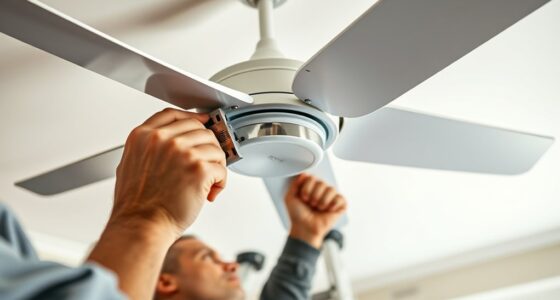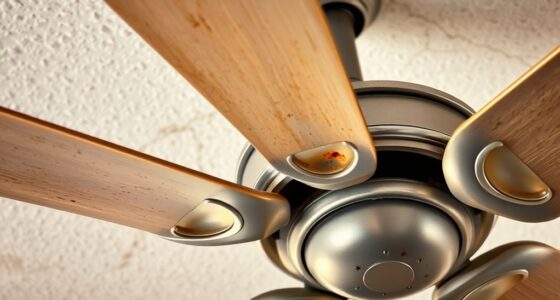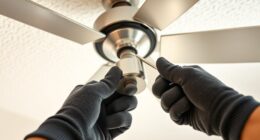To stop ceiling fan squeaks, start by inspecting and cleaning the blades to remove dust and debris, then tighten any loose screws or brackets. Check the motor bearings for dryness or wear, and lubricate them with a suitable lightweight oil if needed. Confirm the mounting bracket and downrod are secure and properly aligned. If the squeaking persists, damaged blades or worn bearings may require replacement. Continuing with these detailed tips will help you identify and fix common causes effectively.
Key Takeaways
- Regularly clean fan blades and mounting hardware to remove dust and debris that cause squeaking.
- Tighten loose screws, bolts, and mounting brackets to prevent vibrations and noise.
- Lubricate motor bearings with appropriate lightweight oil to reduce friction and squeaks.
- Check for and replace damaged or warped blades and bent downrods to maintain balance.
- Inspect and tighten the entire mounting assembly, and replace worn components if squeaks persist.

A squeaking ceiling fan can be both annoying and disruptive, often signaling underlying mechanical issues that require immediate attention. This noise typically indicates friction or looseness within the fan’s moving parts, which, if left unaddressed, can lead to more severe damage or operational failure. To effectively troubleshoot and resolve this issue, you need to understand the specific components that contribute to squeaking and how to methodically inspect and maintain each one.
First, examine the fan blades and their mounting hardware. Over time, dust and debris accumulate along the blade edges and mounting points, increasing resistance and causing squeaks during rotation. Using a soft cloth, clean each blade thoroughly, paying close attention to the blade brackets and screws. Tighten any loose screws or bolts, as even minor looseness can generate vibrations and noise. If the blades are warped or damaged, replacing them is advisable, since uneven surfaces disturb aerodynamic balance and generate friction.
Clean and tighten fan blades and mounting hardware to prevent squeaks and ensure smooth operation.
Next, focus on the fan’s motor assembly and shaft. The motor bearing is a common culprit in squeaking sounds. Bearings are lubricated with grease or oil that can dry out or degrade over time, increasing friction. To check this, switch off the fan and carefully access the motor housing following manufacturer instructions. If you notice rust, corrosion, or a dry, gritty feel when spinning the shaft manually, the bearing likely needs lubrication or replacement. Apply a high-quality, lightweight machine oil or lubricant specifically designed for fan motors, ensuring you do not over-apply, which can attract dust and dirt.
Additionally, inspect the fan’s mounting bracket and downrod for stability. Loose mounting points allow the fan to vibrate during operation, producing squeaks. Tighten all mounting screws securely, but avoid overtightening, which can crack plastic components or warp metal parts. If the downrod or mounting bracket is bent or damaged, replace these parts to restore proper alignment and reduce unnecessary motion that causes noise.
Finally, consider the age and condition of the fan’s motor and moving parts. Worn-out components can generate abnormal sounds, and in some cases, lubrication alone may not suffice. If lubrication does not eliminate the squeak, or if you detect significant wear or damage, replacing the motor or entire fan assembly might be necessary. Regular maintenance—cleaning, tightening, and lubricating—can prevent future squeaks, but ignoring persistent noise can lead to more costly repairs down the line. Remember that using appropriate lubricants recommended for fans can extend the lifespan of the motor bearings and reduce squeaks effectively.
Frequently Asked Questions
How Often Should I Lubricate My Ceiling Fan?
You should lubricate your ceiling fan every 6 to 12 months to prevent squeaks and guarantee smooth operation. Use a lightweight, 3-in-1 or electric motor oil, and avoid over-lubricating, which can attract dust. Turn off the fan, carefully access the motor housing, and apply a few drops of oil to the motor’s moving parts. Regular lubrication reduces friction, minimizes squeaking, and prolongs the fan’s lifespan.
Can I Fix a Squeaky Ceiling Fan Myself?
Yes, you can fix a squeaky ceiling fan yourself if you approach it as a delicate surgical procedure. First, turn off the power and inspect the blades, mounting, and motor for loose or worn components. Lubricate the moving parts with appropriate oil, tighten screws, and replace any worn bearings. With patience and precision, you’ll eliminate the squeak, restoring your fan’s smooth, silent operation—like a well-rehearsed symphony.
Is It Safe to Use WD-40 on Ceiling Fans?
Using WD-40 on ceiling fans isn’t recommended because it can damage plastic parts and leave residues that attract dust, potentially worsening squeaks. Instead, you should use a lubricant specifically designed for fans or electrical components, such as a silicone-based spray or light machine oil. Turn off the fan, dust off the blades, and apply the lubricant to the motor’s moving parts, ensuring you avoid electrical components for safety.
When Should I Replace My Ceiling Fan Instead of Fixing It?
When your ceiling fan keeps giving you trouble despite repairs, it’s time to call it quits. You should replace your fan if it’s over 10-15 years old, shows persistent wobbling, excessive noise, or faulty wiring that repairs can’t mend safely. If the motor burns out or the blades are cracked beyond repair, replacing guarantees safety and efficiency. Don’t throw good money after bad—sometimes, a new fan is the wisest choice.
Do Ceiling Fan Squeaks Indicate Electrical Issues?
Ceiling fan squeaks typically don’t indicate electrical issues; instead, they often result from mechanical problems like worn bearings, loose blades, or dust buildup on the motor or blades. If your fan squeaks, focus on inspecting and lubricating moving parts rather than checking wiring. Electrical problems usually cause the fan to stop working altogether or flicker, not produce squeaking sounds. Proper maintenance can often resolve the squeak without electrical intervention.
Conclusion
Regular maintenance can considerably extend your ceiling fan’s lifespan and reduce noise. Did you know that improperly lubricated fans are responsible for up to 70% of squeaking issues? By inspecting and lubricating bearings, tightening loose parts, and replacing worn components, you guarantee ideal performance and quieter operation. Addressing squeaks promptly prevents further damage and costly repairs. Stay proactive with your fan’s upkeep—this small effort yields long-term benefits in efficiency and noise reduction.









